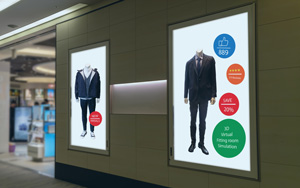 by Bobby Marhamat
by Bobby Marhamat
Prices matter, but for the consumers of today, numbers are less important than the experiences that surround them. In the new age of commerce, both online and in stores, shoppers usually have several options for where to buy. Using their smartphones, they can stand in front of products in stores and find the best price online within a few seconds.
In some cases, they can even limit their searches to local options. This evolution of price and product access means retailers cannot compete solely on price to keep customers coming through the door.
Better in-store experiences attract customers to retail locations in situations when they might have otherwise shopped online. Retailers don’t have to host carnivals and concerts to offer great experiences, though. In most cases, factors like cleanliness, organization, and staff helpfulness make a bigger difference than additional entertainment. The experience isn’t about adding bells and whistles to the shopping but about making the shopping easier and more meaningful.
Advantages of Digital Signage Today
In pursuit of this ideal retail experience, digital signage empowers brick-and-mortar stores to offer the kinds of conveniences that today’s customers prioritize. Let’s explore a few of the ways that digital signage can appeal to shoppers in 2020:
1. Adding an Interactive Element
Static signs are just that — static. They don’t respond to customer presences, and they certainly can’t personalize their content to match the tastes of the people in front of them. Their messages stay the same no matter what.
Digital signage, however, offers something much more interesting. With digital alternatives, retailers can boost shoppers’ brand engagement by using video or personalized content. Moving screens, special offers, and location-specific messaging can all keep eyeballs on content for longer, increasing the odds that the person watching will make a purchase or spend more time in the store.
2. Leveraging Smarter Tools
On its own, digital signage boasts impressive improvements to the customer experience. When combined with other tools, however, it becomes an even more potent component of the modern retailer’s arsenal.
Take artificial intelligence, for example. Imagine having a screen in a store that could respond not only to the flick of a switch, but also to its own environment. Screens could save energy by turning themselves off when not in use, then activate using IoT sensors when customers walk nearby. Digital signage with AI can even pick up information from nearby smartphones to change content based on the profile of the user.
Think about the applications of this tech for loyalty programs or repeat customers. Someone who visits for the first time may see one set of deals, while a long time buyer might see ads for items that complement previous purchases.
3. Guiding Buyers Down the Funnel
All of these potential uses for digital signage sound exciting, but how do they make stores money? By using digital signage to accelerate and deepen engagement with customers, stores can provide more relevant information at the critical moments of shopper’s journeys. These moments of decision range from whether to make the purchase to whether to walk over and check out a shelf. Deepening engagement through digital signage creates more opportunities for stores to showcase their products and deals.
Once customers are attracted by appealing content, like video or dynamic visuals, digital signage can help get items into carts by showing relevant information to encourage purchases. That information can vary based on how the store wants to communicate. Some stores may show competitor’s prices to prove their own value, while others might highlight the usefulness of the products on display.
Make the Most of Digital Signage
Just like any tool, digital signage works best in the hands of people who understand how to make the most of its potential. Retailers who have not yet experimented with digital signage should follow a few basic best practices:
- Identify the target customer. Who are the people shopping in the store? What are their needs, which products appeal to them, and what role does digital signage play in that relationship?
- Experiment with engagement techniques. Consider tactics to engage target customers. A/B test different uses of digital signage to see which ones lead to the most sales.
- Create a dynamic plan for content and engagement. After learning which techniques work best, create more content for digital signage to deepen engagement. If customers spend a lot of time using augmented reality features, for instance, add more signs with AR capabilities and develop more AR content.
The retail world, shocked by the recent pandemic, will not get any easier after the masses return to shop. Many stores may close, but the ones that remain must compete for the attention of a limited number of customers, many of whom will be more selective about the time they spend outside the home. In-store experiences will determine which stores earn repeat business, and in the pursuit of the best experiences, digital signage will be savvy retailers’ most potent weapon.
Bobby is the CEO of Raydiant, a digital signage provider that helps businesses turn their TVs into interactive signs that drive sales, improve the in-store experience, and reinforce brand messaging. Prior to joining Raydiant, Bobby served as the COO of Revel Systems where he worked on the front lines with over 25,000 brick and mortar retailers.
